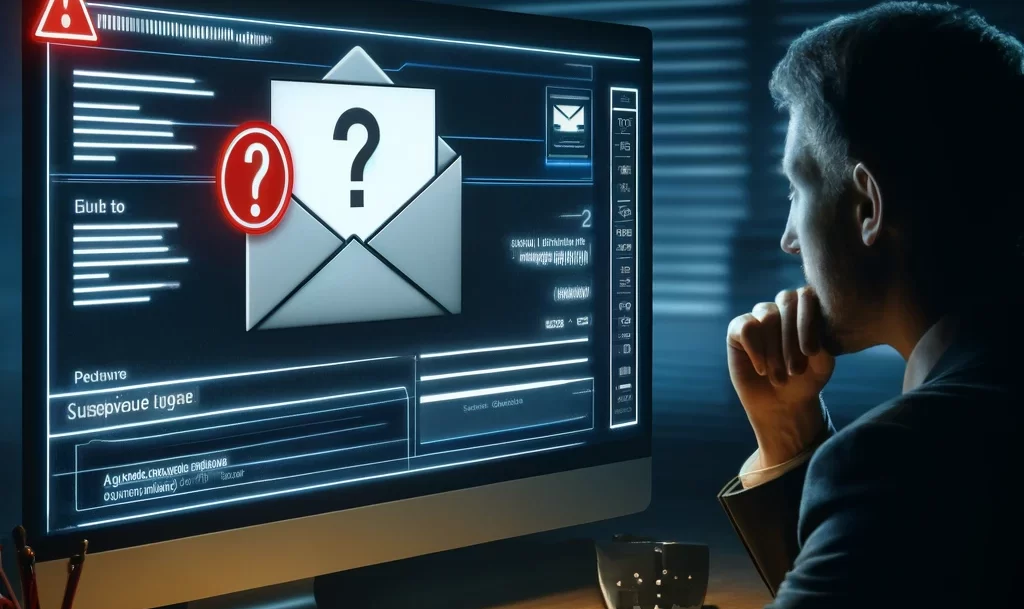KEY TAKEAWAYS
Suspicious emails are communications sent over email with potentially malicious intent or content aimed at deceiving, harming, or exploiting the recipient.
These emails often attempt to steal sensitive information, deliver malware, or trick the recipient into performing actions that compromise their security or well-being. Here are some common characteristics and purposes of suspicious emails:
Characteristics of Suspicious Emails:
Purposes of Suspicious Emails:
Awareness of these characteristics helps individuals and organizations recognize and avoid potentially harmful email interactions, thereby protecting their digital and personal assets.

In the vast and interconnected world of digital communication, email remains a primary tool for personal and professional correspondence.
However, this ubiquity also makes email a favored target for cybercriminals. This blog post will delve into practical strategies and tools, including managed SIEM and services provided by managed service providers, to help individuals and organizations avoid suspicious emails and enhance their cybersecurity posture.
Suspicious Emails: A Gateway to Cyber Threats
Suspicious emails often serve as the front line for various cyber threats, from phishing scams to malware distribution.
Recognizing the characteristics of these malicious communications is essential for preventing potential breaches and protecting sensitive information.
Key Indicators to Watch Out For
Identifying suspicious emails can be straightforward if you know the key indicators that characterize such communications. Recognizing these signs not only aids in promptly detecting potential threats but also empowers users to handle them proactively and effectively. Below are detailed explanations of each of these key indicators:
Unexpected Attachments: One of the most common tactics used in phishing and malware distribution involves sending emails with attachments the recipient did not anticipate. These attachments may be disguised as invoices, receipts, or documents that require urgent attention. Users should be wary of opening any attachment they were not expecting, particularly if it comes from an unfamiliar source.
Generic or Odd Greetings: Phishers often send bulk emails that do not address recipients by name. Instead, these emails may use vague and impersonal greetings such as “Dear Customer” or “Dear Sir/Madam.” Occasionally, the attempt to personalize the email might go wrong, resulting in odd or incorrect names or titles, which can also be a red flag.
Misspellings and Poor Grammar: Many suspicious emails contain noticeable grammar and spelling mistakes. While everyone can make a typo, professional communications from reputable organizations are typically proofread and clear of such errors. Excessive errors in an email suggest it might be from a scammer, particularly one operating from a country where English is not the primary language.
Urgent Requests That Seem Out of Character: Cybercriminals commonly use urgency to create panic and prompt hasty actions from the recipient. For example, an email might claim that your account will be closed or you will incur a fine if you do not act immediately. This strategy plays on fear and can lead to rushed decisions, like providing confidential information or clicking on a dangerous link.
Links with Mismatched URLs: Often, suspicious emails will include hyperlinks that purport to lead to well-known websites but, on closer inspection (such as by hovering over the link with your mouse), show a different URL. This tactic deceives the recipient into visiting malicious websites to steal personal information or deliver malware.
Sender’s Email Address: A glance at the sender’s email address may reveal discrepancies that raise suspicion. Cybercriminals may use addresses that mimic legitimate ones by adding extra letters or misspelled words. For instance, an email from “support@amaz0n.com” instead of “support@amazon.com” should trigger a warning.
Enhancing Detection and Response Capabilities
Managed Security Information and Event Management (SIEM) significantly enhances an organization’s ability to monitor and respond to suspicious email activities.
By aggregating and analyzing log data from email servers, network traffic, and other sources, managed SIEM systems offer a comprehensive overview of an organization’s security landscape.
This integrated analysis helps identify unusual patterns and potential threats, such as phishing attempts or malware distribution, allowing prompt and effective intervention.
Managed SIEM systems have sophisticated tools for real-time alerting and automated response mechanisms.
When a suspicious activity is detected, these systems can immediately alert security personnel and, depending on the configuration, perform automated actions like isolating affected systems or blocking suspicious IP addresses.
This immediate response capability is critical in mitigating the impact of email-based attacks and maintaining continuous security monitoring without requiring constant manual oversight.
Additionally, managed SIEM plays a vital role in regulatory compliance and forensic investigations.
It systematically compiles detailed logs of all security-related events, including email transactions, crucial for compliance audits and post-incident analyses.
This capability helps organizations meet stringent regulatory requirements and provides valuable insights into the nature and method of attacks, aiding in the refinement of future security strategies.
Expert Assistance in Email Security Management
Managed service providers (MSPs) offer specialized expertise in managing and securing email systems.
They implement robust security measures, conduct regular audits, and provide training to ensure organizations can recognize and avoid suspicious emails.
Expertise and Support in Handling Updates
Managed service providers (MSPs) are invaluable in maintaining an organization’s software updates.
They can handle the logistics of deploying updates across complex networks, ensuring that all systems are consistently protected against the latest security threats.
Fostering Awareness and Responsiveness
Establishing a culture of security within an organization involves more than just the mere implementation of security tools.
It’s about creating an environment where every employee is deeply aware of the critical importance of remaining vigilant against email threats and is empowered with the knowledge and resources to respond effectively.
This includes conducting regular training sessions to increase awareness and providing timely updates on the latest tactics used in email scams.
By fostering a culture where security is valued and actively practiced, the organization can better protect itself against potential cyber threats and ensure a safe and secure working environment for all its employees.
We provide a range of cyber security professional and managed services. We will work with you to create the solution that manages your needs, your way.
Address: 4412 14th Ave, Markham, ON L6G 1C6
Phone: (647) 360-1551